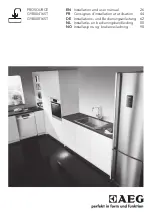
GOLD CGi Gas-Fired Water Boiler — Boiler Manual
6
Part Number
550-110-710/0107
BOILER-bypass piping
method
This piping method (
Figure 22
or
23
) is called a
boiler-
bypass
because part of the circulator flow is bypassed
around the boiler (through valve
7a
). This method
reduces the flow rate throughout the boiler, in order
to raise the average water temperature in the boiler
enough to prevent flue gas condensation. Boiler-bypass
piping is effective for some boilers — including the CGi
— provided the flow rates are adjusted according to the
instructions following.
Figures 22
and
23
are alternative piping suggestions
for
converted gravity
(large water content or steam
systems) or
radiant heating system
— for use when
primary/secondary piping can’t be applied. (
Figure 24
is another alternative, using system bypass in place of
boiler-bypass piping.
Figure 24
however, is not suitable
for radiant heating applications because it does not
protect the radiant system from possible high water
temperature.)
Boiler-bypass piping keeps system flow rate as high as
possible and temperature drop as low as possible, help-
ing to equalize the building heat distribution.
Temperature gauges
Gauge
4a
is optional if the bypass valves will be ad-
Piping — low temperature systems
4d
justed using cold (or room temperature) return water
to the boiler. (When setting the valves without gauge
4a
installed — using cold or room temperature water
— assume the return water temperature to be 60°F. Set
the valves so gauge
8
reads at least 10°F.
Gauge
4b
is optional on converted gravity systems,
but
required
on radiant heating systems — to display
the water temperature being supplied to the radiant
tubing.
Gauge
8
is
required
on all systems to assure reliable
adjustment of the bypass valves. The boiler-mounted
temperature/pressure gauge can be used if a separate
temperature gauge is not installed.
Valve adjustment
1. Start with valve
7a
fully closed and
7b
fully open.
. Gradually open valve
7a
while closing valve
7b
until the temperature at gauge
8
reads 60 °F higher
than gauge
4a
. A minimum 60°F temperature rise
through the boiler assures a low enough flow rate
and high enough average temperature to prevent
condensation even with low system return water
temperature.
3. Valve
7a
regulates the system flow rate, while valve
7b
regulates the boiler flow rate.
4. The boiler-mounted temperature/pressure gauge
may be used in place of a separate gauge
8
.
Failure to
prevent low return water temperature
to the boiler could cause corrosion of
the boiler sections or burners, resulting in severe personal injury, death or substantial
property damage.
Radiant heating system piping should include a means of
regulating the boiler return
water temperature
and the
system supply temperature
(such as provided by an
injec-
tion pumping control
).
Boiler return water temperature will be adequately controlled using the methods shown
in this manual provided the
system supply temperature
is
relatively constant.
DO NOT
apply the methods of this manual if the system is equipped with an
outdoor
reset control.
Instead,
provide controls and piping
which can
regulate the boiler re-
turn water temperature
at
no less than 130°F
regardless of system supply temperature.
Contact your Weil-McLain representative for suggested piping and control methods.
Failure to
prevent cold return water temperature
to the boiler could cause corrosion
damage to the sections or burners, resulting in possible severe personal injury, death or
substantial property damage.
















































